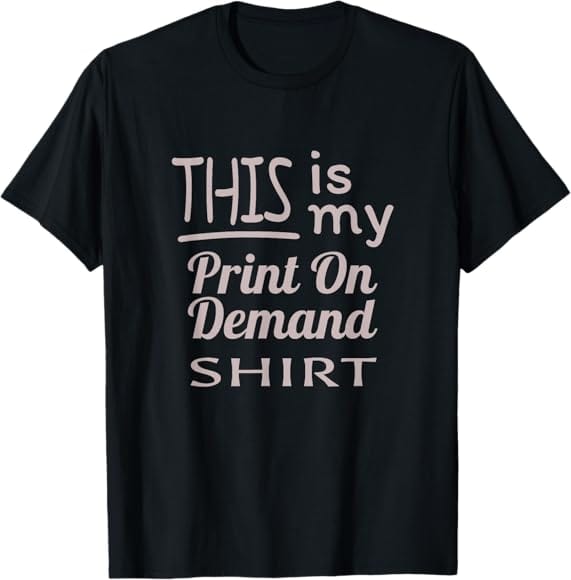Selling t-shirts through a print-on-demand (POD) business model has become an increasingly popular way for entrepreneurs to enter the world of e-commerce. Unlike traditional retail, POD allows sellers to offer custom-designed t-shirts without the need to hold inventory or invest in bulk orders. With the help of platforms like Shopify, Printful, or Teespring, creators can design their apparel and sell it directly to customers online. Each shirt is printed and shipped only when a customer orders, reducing upfront costs and eliminating the risks of unsold stock.
This business model is appealing for its low barrier to entry, making it perfect for individuals who want to turn their creative ideas into wearable art. By combining creativity with digital marketing strategies, such as social media promotions and search ads, POD sellers can reach a global audience and scale their business with minimal overhead. However, success in this space relies on market research, effective advertising, and offering designs that resonate with the target audience.
In my personal experience, pricing t-shirts around $19 is the lowest reasonable price at which you can achieve a 20% profit margin when factoring in the costs of production, advertising, and other business expenses.
Here’s why:
- Production Cost: Typically, the base cost of a t-shirt (including printing) in a POD model is around $7. This covers the manufacturing and printing expenses without any markup for profit.
- Advertising Costs: When selling through platforms like Facebook or Google ads, the cost per acquisition (CPA) can range from $5 to $10 or more, depending on the effectiveness of your campaigns. You must allocate part of your selling price to cover marketing expenses.
- Additional Costs: Other operational costs to consider include transaction fees, shipping (if you offer free shipping), and taxes. These often total around $3, adding to the overall cost per t-shirt.
At a price point of $19, after deducting the base product cost ($7), CPA ($10), and other fees ($3), you cover the necessary expenses while still leaving a small profit margin. With a 20% margin, you make around $3.80 on each sale. This balance ensures that you are covering all your costs and securing a modest profit that can support your business growth.

To determine the ideal selling price for your t-shirts when using Facebook and Google ads, you’ll need to account for a few key factors:
- Cost of Product: $7
- Advertising Costs: You can estimate the cost per acquisition (CPA) from Facebook and Google ads, representing the average cost to acquire one customer.
Let’s break it down:
Steps to Determine Selling Price:
- Estimate Ad Costs:
- On average, you might pay between $5 and $20 or more for each conversion, depending on your ad’s performance, targeting, and competition.
- Factor in Profit Margin:
- You’ll want a profit margin that covers costs and leaves room for a return on your efforts. A standard markup is50%- 1000% or higher, depending on competition and your desired profitability.
- Consider Other Expenses:
- Include shipping, transaction fees, and additional overheads (like platform and payment gateway fees).
- Selling Price Formula:
- Selling Price = (Cost of Product + Average CPA + Other Costs) × Desired Profit Margin
For example:
- Product Cost: $7
- CPA (ads cost): Estimated at $10 (can vary)
- Other Costs: $3 (transaction fees, shipping, etc.)
- Profit Margin: 50%
In this case: Selling Price = ($7 + $10 + $3) × 1.5 = $30
Thus, you’d aim to sell your t-shirts at around $30 or higher to cover your costs and achieve a 50% profit margin. Adjust based on accurate data as your campaign progresses!
If you want to set your selling price with a 20% profit margin, here’s how to calculate it:
Step-by-Step Calculation:
- Product Cost: $7
- CPA (ads cost): Estimated at $10
- Other Costs (shipping, transaction fees, etc.): $3
- Profit Margin: 20%
Formula:
Selling Price = (Cost of Product + CPA + Other Costs) ÷ (1 – Profit Margin)
Since your profit margin is 20%, you would use 0.20 for the profit margin.
Selling Price = ($7 + $10 + $3) ÷ (1 – 0.20)
Selling Price = $20 ÷ 0.80
Selling Price = $25
So, to achieve a 20% profit margin, you should sell your t-shirts at $25.
In conclusion, pricing your t-shirts at around $19 allows you to achieve a sustainable 20% profit margin while covering production, advertising, and additional costs. It’s a practical balance between customer affordability and business profitability. However, careful monitoring of advertising costs and other expenses is crucial to maintaining this margin. Optimizing costs and pricing strategies can help increase profitability over time as your business grows.
Learn more about authors in Nimblefreelancer's team biography page.
- 6 Proven Ways SaaS Founders Actually Get Customers (With Real Examples) - December 17, 2025
- Facebook Ads to Get Followers! - December 27, 2024
- ClickUp vs. Slack - December 20, 2024
- How to Get Free Facebook Traffic Using Pages?
- How to Make $20K Per Month Publishing Facebook Posts? – Full Depth Guide
- Facebook Lead Ads: Cost to Get 1 Newsletter Subscriber
- Maximizing Facebook Ad Performance with Audience Targeting and Scaling Techniques
- How to Improve Facebook Ad Quality Ranking?
- How to Start Selling Hair Bundles? – $2000 Starting Capital Example
- Resolving Facebook Ad Rejections: Understanding the “Ad May Not Run: Potential Policy Issue” and Fixing Landing Page Problems
- Estimating Click-Through Rates from Facebook Group Posts
- Can I Message My Facebook Followers After Promoting a Post? Here’s What You Need to Know About Sending One-on-One Messages
- Facebook Traffic From Page With Zero Followers – Case Study
- How Do I See Hidden Information on Facebook Marketplace?
- You’re not Eligible to Create a Username – Facebook Username Eligibility






